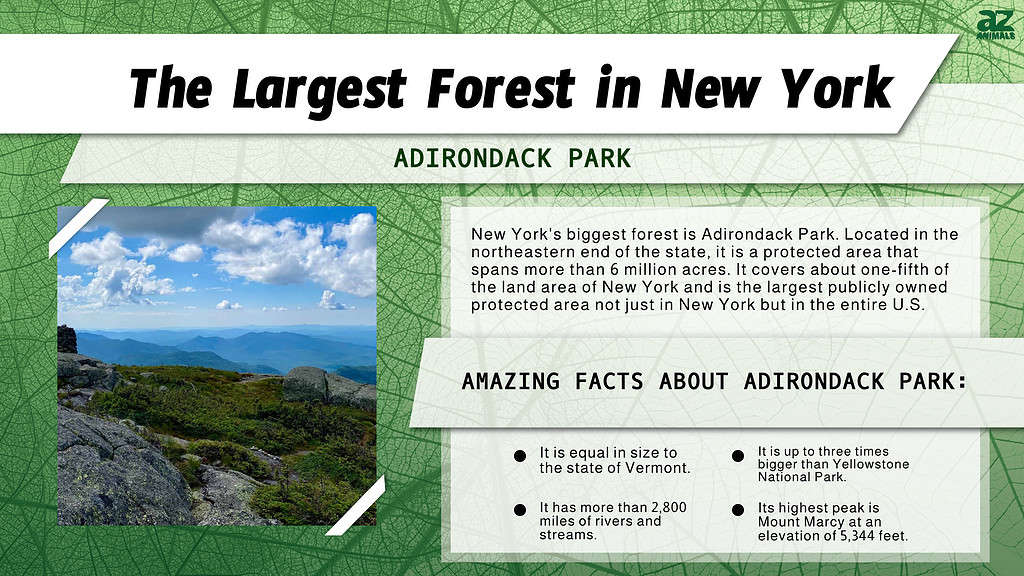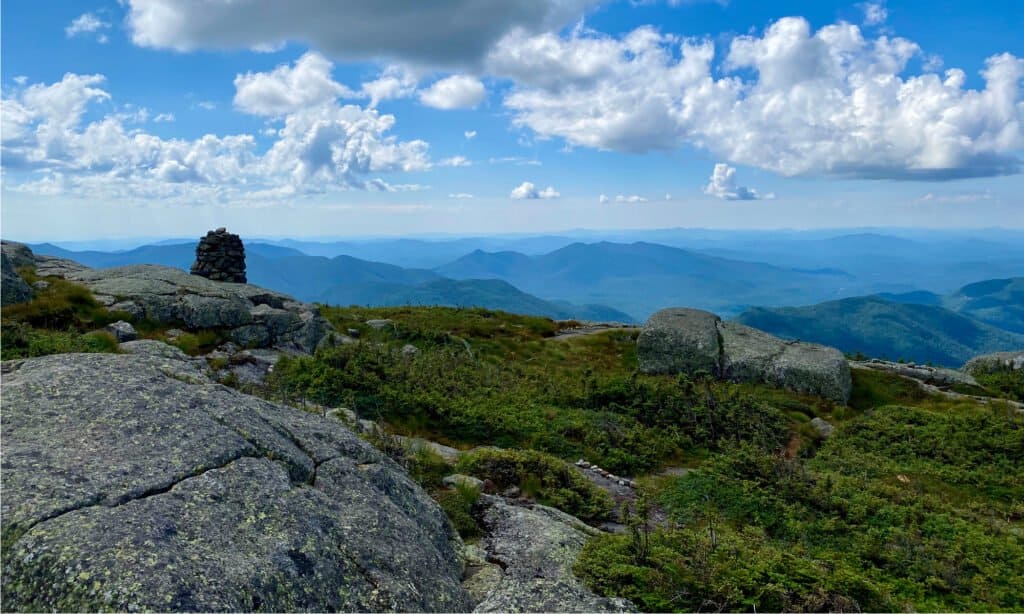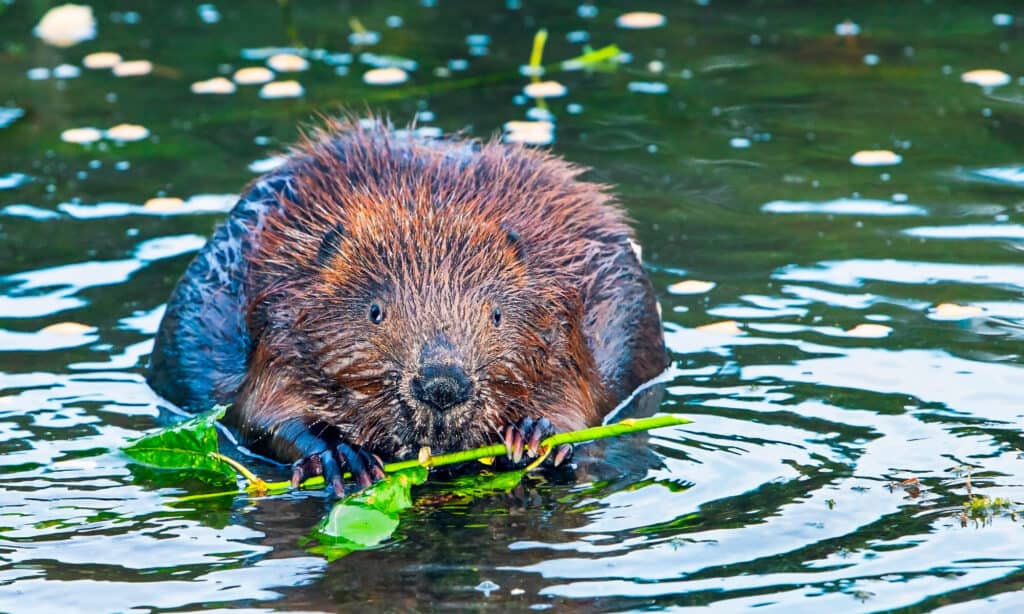The Big Apple has a reputation as a bustling location with vibrant urban life. That’s why it’s shocking news to most people when they discover that most of New York consists of heavily-forested land. In fact, up to 18.6 million out of the 30.2 million acres of land in the state is forested. That’s up to 61% of the land area of the entire state. New York forests are home to more than 100 commercial and non-commercial tree species. Out of all the forested land in New York, one forest takes up about six million acres. That’s roughly one-third of all the forested land in the state.
Known for its serene environment and beautiful views of mountain peaks, the forest park also has several peaceful lakes and ponds and more than 2,000 miles of trails. The large forest provides a rich habitat for different plants and wildlife while also serving for recreation activities like camping, boating, fishing, and so on. Here’s all you need to know about the largest forest in New York.

The Largest Forest in New York: Adirondack Park
The largest forest in New York is Adirondack Park, a protected area located in the northeastern end of the state that covers a land area of more than 6 million acres. This makes it the largest publicly owned protected area not just in New York but in the entire country. However, the park doesn’t contain public land alone; it also has private lands where people live.
Adirondack Park covers about one-fifth of the land area of New York. The park’s land area is equal in size to the neighboring state of Vermont and up to three times bigger than Yellowstone National Park.
The park is home to a diverse range of landscapes, including mountains, lakes, and rivers. The highest peak in the park is Mount Marcy, which stands at an elevation of 5,344 feet. It also includes more than 2,800 miles of rivers and streams, as well as over 3,000 lakes and ponds. Adirondack Park is home to a wide range of plants and animals.

Adirondack Park is the largest forest in New York.
©Kathryn Merrill/Shutterstock.com
History of the Largest Forest in New York
Two Native American tribes, the Mohawks and the Algonquins, originally lived in the Adirondack Forest. These tribes used the land for hunting and fishing, and it also served as an accessway to other areas of the state.
The name “Adirondack” is often translated as “barkeater” or “those who eat trees.” The native Mohawk people used this term to describe the Algonquins who were settled in the Northern end of the region at the time.
In the early 1800s, the State of New York started selling the Adirondack lands to private individuals and lumbermen in order to raise funds to settle debts incurred from the revolutionary war. Tourism boomed in the region in the second part of the 19th century thanks to the construction of a railroad linking Saratoga Springs to North Creek. By 1875, the Adirondacks had more than 200 hotels. The area enticed visitors who wanted to experience nature at its finest.
However, the scramble for the region’s resources led to an overexploitation of the forest area. Towards the end of the 19th century, it became more apparent that the area needed some intervention. In 1873, Verplank Colvin, a lawyer who had carried out an extensive survey of the area, published a report on the deterioration of the watershed due to lumbering activities. His report revealed that the overexploitation of the Adirondack Forest was a threat to the Erie Canal, and he recommended the creation of a state forest preserve.
The State of New York created the Adirondack Park in 1892. By 1894, the state’s legislative commission passed a law to designate the Adirondack forest reserve as wild forest lands forever.
Where Is Adirondack Park Located on a Map?
Adirondack Park is located in northeastern New York, near the towns of Potsdam and Lake Placid, home to the 1980 Winter Olympics.
Wildlife Found in the Adirondack Forest
About 53 mammals and more than 35 species of reptiles and amphibians live in Adirondack Park. The forest lands are also home to numerous birds and insects. Several fish species live in the more than 3,000 lakes and ponds in the forest.
Some mammals most commonly found in Adirondack Park include black bears, moose, white-tailed deer, beavers, river otters, and coyotes. Black bears are common in the park. They’re often seen foraging for food in the summer and fall. Moose can be found in wetland areas and along rivers. White-tailed deers are also abundant and are seen throughout the park. Beavers are found in the park’s wetlands, building dams to create habitat for themselves and other species. River otters and coyotes are less common, but they’re present as well.
Some of the bird species found in the park include the peregrine falcons, bald eagles, cardinals, blue jays, chickadees, and common loons. The park also shelters several species of woodpeckers, including the pileated woodpecker (the largest woodpecker species in North America).
The garter snake, the black rat snake, and the eastern hognose snake are some of the most common reptiles that you may find in this forest park. Turtles (the painted turtle and snapping turtle), as well as lizards and salamanders, are present as well.
The Adirondacks have more than 30,000 miles of streams and rivers flowing through them. The vast waterways of this forest are home to countless fish species, crustaceans, and other wild aquatic life. Some of the most common fish here include the brook trout, rainbow trout, bass, and pike.

Beavers are found in Adirondack Park’s wetlands.
©SERGEI BRIK/Shutterstock.com
Trees in the Largest Forest in New York
Adirondack Park is one of the largest boreal forests in the United States. It is home to trees adapted to survive through long periods of freezing temperatures. They include pines, larches, and spruce trees.
The distribution of arboreal life in the park varies based on the terrain in the area. In general, there are about 100 species of trees native to the Adirondacks region. Northern hardwood trees like sugar maple, yellow birch, and American birch cover up to 60% of the forest. Old-growth forests cover more than 100,000 acres of land in the park. Other forest types include alpine, hardwood conifers, conifer swamps, and mountain conifers.

The yellow birch is a common tree in Adirondack Park.
©iStock.com/Chantale Ouellet
Ecological Significance
Adirondack Park is the largest protected area in the United States. It is known for its diverse and rugged landscapes like mountains, forests, lakes, and wetlands. But more importantly, the large preserve protects several plants and animal life, including many that are considered endangered and threatened in other parts of the country. Some of these species include the dwarf wedge mussel, the eastern wolf, and the spruce goose.
Despite being protected land, most of the land in the Adirondack Park is privately owned. However, all lands in the region are under the control of the Adirondack Park Agency. There are up to 132,000 permanent residents occupying the 102 towns in the region. This integration of human communities into a protected forest area is one of the unique parts of the forest. It demonstrates how ecological conservation can be incorporated into an industrialized world without harming the natural ecosystem.
Tourism and Recreation Activities
About 7 million to 12.4 million tourists visit Adirondack Park yearly. These tourists participate in a wide range of outdoor recreational activities for visitors. Some of these activities include:
- Hiking and camping: The park is home to many trails that wind through the region’s mountains, forests, and lakes. There are many campsites and cabins available for overnight stays.
- Boating and fishing: The Adirondack forests have thousands of lakes and streams, making it an excellent destination for boating and fishing.
- Snowboarding: The park has several ski resorts that oversee downhill skiing and snowboarding in the winter months.
- Biking: At the Adirondack Park, there are many trails and roads that are suitable for tourists interested in biking. Several bike rental companies offer road and mountain bikes for tourists.
- Sightseeing: The park has lots of serene places and beautiful views of the forest. There are also several small towns and villages in the park that are worth exploring. It is a unique forest reserve.
Conclusion
Adirondack Park was created in 1892 to preserve and protect nature while also making it possible for people to experience nature out in the wild. It is a unique forest that includes human communities who contribute in one way or the other to the region’s conservation and protection.
The photo featured at the top of this post is © iStock.com/brandtbolding
Sources
- Adirondack Council, Available here: https://www.adirondackcouncil.org/page/the-adirondack-park-19.html
Thank you for reading! Have some feedback for us? Contact the AZ Animals editorial team.







